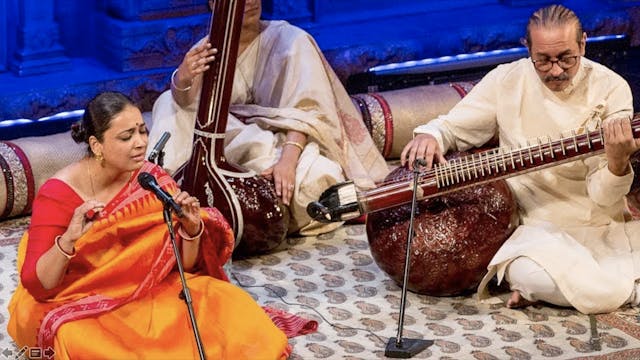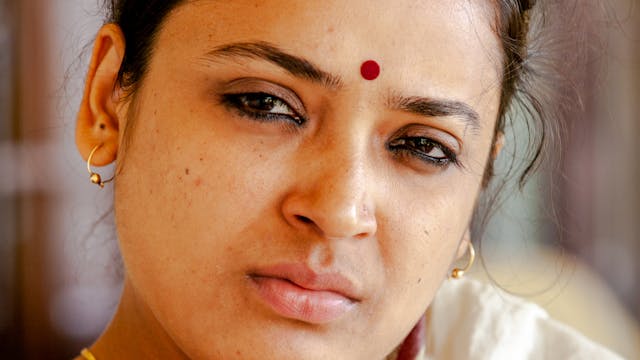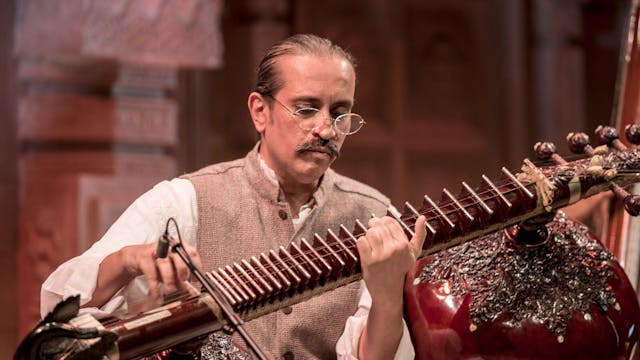Ustad Wasifuddin Dagar | Ahir Bhairav
Dhrupad
•
1h 6m
Recorded at Darbar Festival 2018 on 27 Oct, at London’s Barbican Centre.
Musicians:
- Ustad Wasifuddin Dagar (dhrupad vocal)
- Sukhad Munde (pakhawaj)
- Priya Prakash (tanpura)
Raag: Ahir Bhairav, Thaat: Bhairav, Samay: 6 am to 9 am
Ahir Bhairav is a blend of two ragas – Bhairav, an ancient scale and Ahiri that owes its origin to a folk melody belonging to ‘Ahir’ or cowherds' communities residing on the fertile plains of the two Indian rivers – Ganga and Yamuna.
Ahir Bhairav is coloured with the pensive, early morning flavours of Bhairav in the lower octave. From its middle to the upper octaves, it comes under the joyful influence of Raag Ahiri with distinctly positive emotions of hope and unconditional love.
Ustad Wasifuddin Dagar’s recitals are a delightful soundscape of melody and silence positioned aptly. While the melody stirs a restrained excitement upon the mind, the silence restores it to a state of serenity the next. In this recital, he captures the eclectic mix of emotions of Ahir Bhairav with sparkling clarity and meditative repose.
An expansive alap and jod with effortless swoops to the lower-most octave and back to the middle octave mark the beginning of the recital. He demonstrates the patient and sombre dynamism of Bhairav in the lower octaves and soars to the middle and upper octaves to paint the more joyful emotions of Ahiri. The composition, a dhamar in 14 beats, is first sung in full and thereafter, introduced with melodic variations.
As he unfolds the shape of the raga with clear syllables, he deploys breathtaking modulations and rhythmic control into the phrases. Sukhad Munde performs wonderfully, providing a supportive accompaniment on the pakhawaj. His improvisations are woven around tight rhythmic patterns that walk hand-in-hand with Ustad Dagar’s explorations within the 14-beat cycle.
Ahir Bhairav is derived from the Bhairav thaat (scale) and deploys all notes in its ascent and descent with komal Re (flat 2nd) and komal Ni (flat 7th). The dominant note is Ga (3rd) or Ma (4th) and the sub-dominant note is Sa (1st).
There are several viewpoints regarding its dominant and sub-dominant notes because without distorting its features or chalan (gait), the notes of the raga offer a lot of scope for improvisations. The raga’s poorvang or lower tetra-chord is rooted on Bhairav with due emphasis on its oscillating yet virile komal Re while the komal Ni in its uttarang (upper tetra-chord) brings in the soft hues of Kafi and Bageshri. Interestingly, this compound raga is much more popular than the grandiose Bhairav and in a way reflects the concept of Ardhanareeshara (the composite version of the male and female forms) in the Hindu pantheon.
Up Next in Dhrupad
-
Ustad Bahauddin Dagar & Pelva Naik | ...
Recorded at Ravenna Festival, on 24th June 2017, at Teatro Alighieri, Ravenna, Italy.
Musicians:
- Ustad Bahauddin Dagar (rudra veena)
- Pelva Naik (dhrupad vocal)
- Sudarshan Chana (jori)
- Seetal Dhadyalla and Kruthika Nadaraja (tanpuras)Raag: Vardhani, alap, jod and jhalla, Dhamar in 14 bea...
-
Pelva Naik | Raag Jog
Recorded on location in Mulshi, Maharashtra, India
Musician:
- Pelva Naik (dhrupad vocal)Raag Jog; Thaat: Kafi; Samay: Night
Young dhrupad singer Pelva Naik sings a candlelit solo rendition of Raag Jog, replete with slow slides, meditative microtones, and patient melodic elaboration. At age 1...
-
Ustad Bahauddin Dagar | Been recital
Ustad Bahauddin Dagar plays the Sitar Been at London's Victoria & Albert Museum as part of the Musical Wonders of India project.



